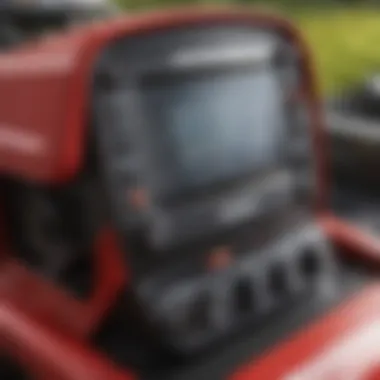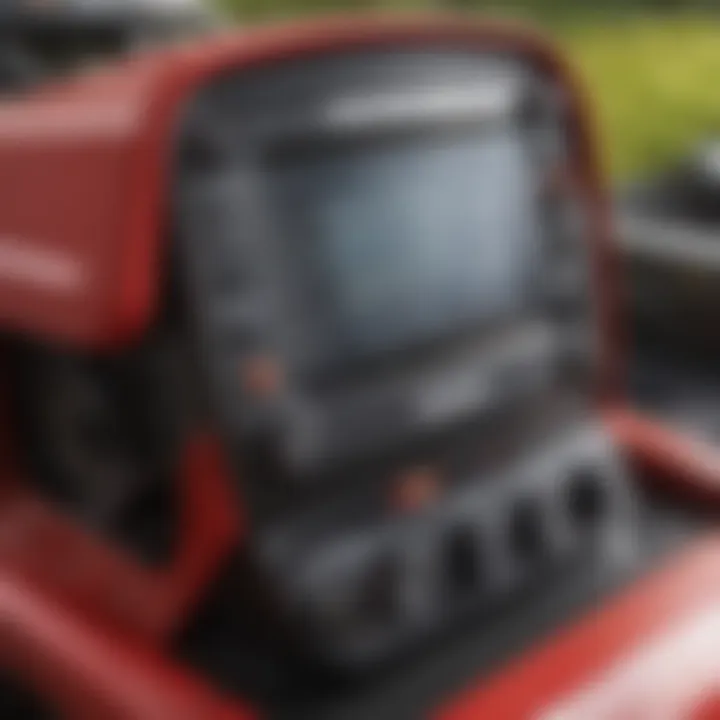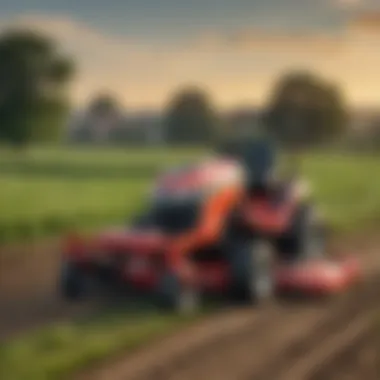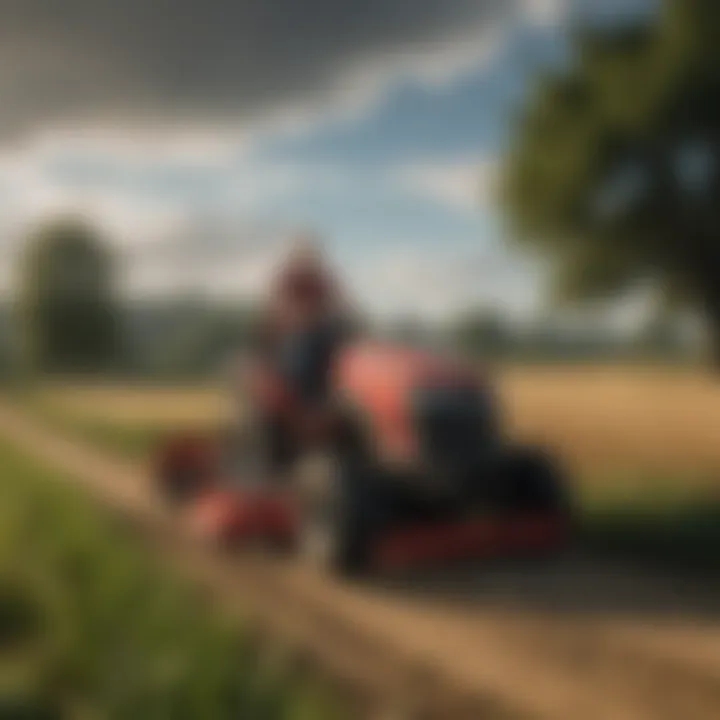Troy Zero Turn Mower: A Guide for Agronomists


Topic Overview
Definition and Importance
In the realm of modern agriculture, efficiency and precision have taken center stage. With vast fields to manage and ever-tightening schedules, farmers need equipment that can keep pace. The Troy zero turn mower stands out as more than just another piece of machinery; it's a game changer. This mower allows users to navigate their farms with remarkable dexterity and speed, proving essential in maintaining landscapes while optimizing workflow.
Farmers might liken operating traditional mowers to steering a ship through stormy seas; they often require wide arcs and substantial clearance to maneuver around obstacles. In contrast, a Troy zero turn mower is akin to dancing on those very waters—it can pivot and cut in virtually any direction, allowing for quick turns around crops and trees. This merging of speed and maneuverability makes it indispensable for agronomists looking to boost productivity on their land.
Brief History and Evolution
The concept of zero turn mowers can be traced back to the mid-20th century, although their roots run deeper in the quest for efficient land management. Originally designed for residential lawns, they gradually found their footing in agriculture as farmers recognized their utility. The evolution of the Troy zero turn has mirrored advancements in technology. Early models were simplistic, often lacking in both comfort and maneuverability. Over the decades, however, innovations such as hydrostatic drive systems and improved cutting decks have elevated these machines into robust tools that cater to the multifaceted needs of the agricultural community.
Today, the Troy zero turn mower embodies decades of research and development, symbolizing a blend of tradition and modernization. This adaptability means it isn't just confined to regular mowing; it can easily handle duties from weed control to mulching, proving its worth across diverse agricultural practices.
Key Techniques and Innovations
Sustainable Farming Practices
In a world where the notion of sustainable farming is increasingly pertinent, the Troy zero turn mower shines brightly. With its efficiency, it can significantly reduce fuel consumption during operation, a small yet meaningful step toward lessening the carbon footprint of agricultural practices. Farmers are encouraged to leverage this machine not just to maintain aesthetics, but to promote environmental stewardship.
Mowing less frequently and at optimal times can also minimize harm to local wildlife, preserving natural habitats while managing farm landscapes effectively. The sophisticated design of the Troy allows agronomists to cut longer grass in designated areas, enhancing soil health by promoting biodiversity and nutrient cycling.
Advanced Agronomic Technologies
Modern technology doesn't stop at the mower itself; it encompasses various enhancements that make the Troy zero turn a vital asset. Many models now integrate GPS technology, allowing for precise mowing patterns and the ability to track operational metrics. This is especially useful in large-scale farming where missed patches can translate into lost time and money.
Moreover, some Troy models now come equipped with smart engine management systems that optimize power usage based on the terrain being worked on. These advancements not only increase the machine's life span but also improve overall performance.
Practical Applications
Step-by-Step Guides
To truly harness the potential of a Troy zero turn mower, proper operation is key. Here’s a simple guide to get started:
- Pre-Operation Checks: Ensure all systems are functional, including brakes, steering, and cutting blades. Always check the fuel and oil levels as well.
- Adjust Cutting Height: Depending on the specific needs of your land, adjust the cutting height to suit the current season. A higher cut may protect grass roots during hot months.
- Plan Your Route: Efficiently plan your mowing route to prevent excessive overlap and to maximize coverage. This keeps your mowing efficient and quick, saving both time and fuel.
- Maintenance: Regular maintenance keeps the mower in optimal condition. This includes cleaning debris from the deck and servicing the engine.
Case Studies or Real-World Examples
Take, for instance, the experience of a Midwestern farmer who transitioned from a traditional riding mower to a Troy zero turn. Previously, maintaining his sprawling fields was a daunting task, fraught with delays and inefficiency. After making the switch, he reported a 30% reduction in mowing time, allowing him to allocate more resources toward crop management and soil health initiatives.
In another example from a community-supported agriculture farm, much of their land consisted of intricate plots where traditional mowers simply couldn't reach. The zero turn mower enabled them to navigate these spaces efficiently, maintaining not just their crops but also the integrity of the surrounding ecosystems.
In summary, the Troy zero turn mower is not merely a tool; it represents a shift in how agricultural tasks can be approached and achieved. As agronomists continually seek innovative solutions, this type of equipment plays a pivotal role in shaping the future of sustainable farming.
Intro to Troy Zero Turn Mowers
Understanding the nuances of modern turf management goes beyond just the tools used in the field; it encompasses how these tools can enhance overall agricultural productivity. The Troy Zero Turn mower stands out in this regard, offering capabilities that can tilt the scales in favor of precision, efficiency, and care in maintaining large areas, whether they're sprawling farms or manicured lawns. This section aims to decode the important features and benefits that come with using Troy Zero Turns, particularly for those who make their living from the land.
Overview of Zero Turn Technology
Zero turn technology in mowers allows for an unprecedented level of maneuverability. This isn't merely theoretical; it's a game changer on the ground. Unlike traditional lawn mowers that require substantial space to pivot or turn, zero turns can spin on a dime. This attribute is essential when navigating around trees, flower beds, or intricate landscaping without disturbing the soil or the plants. The dual-lever steering system places control firmly in the operator’s hands, enabling swift directional changes that minimize the time spent mowing while maximizing coverage.
In practical terms, the benefits are manifold. Farmers or landscapers often face tasks in highly crowded environments where maintaining clean lines and consistent cut quality is paramount. With a Troy Zero Turn, achieving that meticulous finish isn’t just possible; it’s a promise. Moreover, the efficiency doesn't just stop at cutting; it extends to the very essence of turf management—fertilizing, watering, and general upkeep. The technology allows users to engage more intricately with their landscaping, leading to healthier crops or lawns as time goes on.
Troy's Innovations in Mowing
Troy has consistently led the pack in innovating mower technology, ensuring that their models are not just functional but groundbreaking within the agriculture sector. One notable advancement lies in the engineering of the drive system. Troy zero turns incorporate a hydraulic drive, which provides smoother acceleration and deceleration, allowing for greater control when cutting different turf lengths.
Another noteworthy innovation is the incorporation of high-efficiency cutting blades that not only maximize the mower's ability to manage grass at various heights but also extend the mower's lifespan due to less wear and tear. These blades can cut efficiently while moving at higher speeds, ensuring that users complete their tasks faster than ever before with no compromise in quality.


Furthermore, Troy's attention to user comfort cannot be overstated. The ergonomic seat design, combined with vibration dampening materials, means less fatigue during long mowing sessions. This aspect is crucial because long hours in the field can take a toll on even the most seasoned farmers.
"The combination of technology and comfort in Troy Zero Turn mowers sets new standards in the agricultural equipment landscape, fostering better results and user satisfaction."
Design and Functionality
Understanding the design and functionality of the Troy zero turn mower is crucial for any modern agronomist keen on enhancing their operational effectiveness. The design elements dictate how the mower can be utilized in various agricultural tasks, affecting everything from maneuverability to cutting precision. An efficient design not only supports improved performance under different conditions but also ensures that users can easily operate and maintain the equipment, ultimately leading to better outcomes on the field.
Structural Features of the Troy Zero Turn
The structural features of the Troy zero turn mower set it apart from conventional mowers. One standout aspect is its frame construction, which employs durable steel materials that provide a stable base. This design contributes to increased longevity and resilience under demanding working conditions. The low center of gravity enhances stability, making it easier to navigate uneven terrain, which is a common occurrence in agricultural settings.
Moreover, the mower features a comfortable operator platform that ensures the user can work for extended periods without discomfort. This is critical since many agricultural tasks can be time-consuming. The adjustable seat and ergonomic control layout mitigate fatigue and allow operators to maintain focus on the task at hand. Utilizing such thoughtful structural design is key to maximizing efficiency and productivity in farming operations.
Engine Specifications and Power Output
Moving on to the engine specifications, the Troy zero turn mower doesn't cut corners. The powerful engine options combine high torque with efficiency, giving users the ability to tackle tough mowing jobs with ease. For instance, the Kohler and Briggs & Stratton engines found in various Troy models range from 22 to 30 horsepower. This amount of power enables the mower to handle larger cutting decks while maintaining impressive speed and acceleration.
Additionally, the fuel efficiency of these engines deserves attention. Farmers often seek ways to reduce operational costs, and Troy’s engineering achieves a fine balance between power and efficiency. This translates into longer operation times without frequent refueling, allowing agronomists to maintain momentum during critical mowing periods.
Cutting Performance and Blade Technology
When it comes to cutting performance, the Troy zero turn mower excels in delivering precision. The design of the cutting deck itself plays a vital role in this aspect. Troy offers wide-cut decks, generally ranging from 42 to 60 inches, which significantly reduces mowing time, especially in expansive fields. The deck height adjustment feature allows for versatile grass height options, catering to different types of crops or lawn needs.
Furthermore, the blade technology integrates high-lift blades, which are engineered to lift grass for a more even cut. This is essential in providing a clean finish, allowing for better health in lawns and crops, as cut grass can often affect growth if not handled correctly. The ease of blade replacement and sharpening is another positive aspect, ensuring that the mower remains in top condition, providing optimal performance throughout its usage.
"The right design directly influences not just the effectiveness but also the ease of use, which is incredibly valuable in the fast-paced sphere of modern agriculture."
These elements of design and functionality not only enhance the operational capability of the Troy zero turn mower but also represent a commitment to addressing the specific needs of modern agronomists. By understanding how these features work together, users can leverage the full potential of the Troy zero turn mower and apply it effectively in various agricultural contexts.
Benefits of Using Troy Zero Turns in Agriculture
Troy zero turn mowers have steadily made their mark in modern agronomy, proving to be more than just another piece of machinery in the shed. The intricacies of their design and functionality enhance their applicability in the field. Understanding how these mowers benefit agriculture can empower both seasoned farmers and newcomers alike. This section delves into three pivotal advantages: enhanced maneuverability, time efficiency over extensive land, and precision in lawn and crop management.
Enhanced Maneuverability
One standout feature of the Troy zero turn mower is its remarkable maneuverability. Unlike traditional mowers that tend to require wide arcs to change direction, a zero turn mower can pivot on its own axis. This means it can navigate around tight corners, flower beds, and other obstacles with ease. Imagine having to trim around an orchard with various tree placements; a Troy zero turn helps avoid the hassle of backing up and adjusting the mower's position repeatedly.
With a cutting radius that feels practically zero, this capability allows farmers to easily manage irregular fields or uneven terrains. Consequently, operators can save time and minimize wear on both the machine and the landscape. This enhances overall productivity because less time spent maneuvering translates to more time caring for crops and improving yields.
Time Efficiency in Large Areas
When it comes to covering large areas, Troy zero turn mowers really shine. Equipped with powerful engines and wide cutting decks, these mowers can reduce mowing time significantly compared to pushing a traditional lawn mower. For farmers managing extensive land for crops, a Troy zero turn can operate swiftly without sacrificing cut quality.
Often, the simplicity of operation adds to time efficiency. Farmers can focus less on technical adjustments and more on doing what they do best—farming. With larger fuel tanks and optimized cutting paths, the function of these mowers can lead to staggering time savings during peak growing seasons. Tasks that could take hours may shrink into a fraction of that, allowing farmers to attend to other urgent job requirements.
"Time is money in farming, and every minute saved during the mowing process opens windows for other critical farm tasks."
Precision in Lawn and Crop Management
Precision in lawn and crop management is essential for maintaining a healthy agricultural landscape. The Troy zero turn's adaptability allows farmers to trim neatly around crops or landscaped areas without risking damage. This kind of control is especially beneficial when tending to vulnerable seedlings or flower beds that require careful handling.
Additionally, many models come equipped with adjustable blades that can be tweaked to different heights according to the specific needs of the plants. Whether it's maintaining a sleek, manicured lawn or ensuring crops thrive without competing with excessive grass growth, the ability to set cutting heights can lead to significant improvements in maintenance quality.
Moreover, with improved visibility from the operator's seat, users can execute cuts with surgical precision. This meticulousness helps in avoiding damage to crops while maintaining an aesthetically pleasing environment. Ultimately, in a field where every detail matters, achieving this level of precision can have lasting impacts on crop health and quality.
By understanding the benefits of Troy zero turn mowers, agronomists can enhance operational efficacy on their farms. These advantages collectively contribute to a seamless integration of mowing practices in agricultural settings.
Maintenance and Care
Taking care of a Troy zero turn mower is like cultivating a well-tended garden; it requires attention, dedication, and the right practices. For those in agriculture, the efficiency and longevity of your mowing equipment can significantly impact your operations. Proper maintenance and care are not merely optional; they are essential for the optimal performance of your mower, ensuring that it serves you well through thick and thin.


Regular maintenance can extend the lifespan of the mower and reduce the likelihood of costly repairs. In farming, every minute counts, and downtime can be detrimental. This section will outline critical maintenance procedures, common troubleshooting tips, and seasonal preparation advice for the Troy zero turn mower, geared toward those who understand the significance of keeping their equipment in top shape.
Routine Maintenance Procedures
- Oil Changes: Regular oil changes are vital. Typically, this should happen every 50 hours of use or at the start of each mowing season. This keeps the engine lubricated and operating smoothly.
- Air Filter Cleaning: A clean air filter is like a breath of fresh air for your mower. Check and clean the air filter regularly, especially after heavy use or during dusty conditions.
- Blade Sharpening: Sharp blades contribute to a cleaner cut and healthier grass. It's recommended to sharpen the blades every 20-30 hours. If you notice uneven cuts, odds are the blades need attention.
- Tire Pressure Checks: Proper tire pressure helps with maneuverability and weight distribution. Make it a habit to check your tire pressure regularly.
- Battery Maintenance: Ensure battery terminals are clean and free from corrosion. A well-maintained battery will start reliably every time.
These steps may sound simple, yet they are crucial for achieving peak performance. Staying on top of these maintenance procedures can save time and costs in the long run.
Troubleshooting Common Issues
Even with rigorous maintenance, challenges can arise. Knowing how to troubleshoot common problems can save headaches in the field.
- Engine Won't Start: Check the fuel levels, battery connections, and if the safety switch is engaged.
- Uneven Cutting: This could be due to dull blades or improper tire pressure. Address these issues before they create larger problems.
- Transmission Issues: If you notice reduced speed or responsiveness, inspect the transmission fluid levels or look for blockages in the drive system.
- Electrical Failures: Fuses may blow or connections could become loose over time. Regular checks can help you catch these before they lead to bigger issues.
Proper troubleshooting can prevent further complications and ensure your mower continues to operate effectively.
Seasonal Preparation Tips
As the seasons change, so should your maintenance approach:
- Spring Tune-Up: At the beginning of the season, do a complete check. Change the oil, replace the filters, and ensure all systems are functional. This sets a solid foundation for the busy season ahead.
- Summer Care: During peak usage, monitor fuel levels and heat levels closely. Hydration is key—not just for the farmer but also for keeping the mower cool during long hauls.
- Fall Wrap-Up: After the last cut of the season, it’s essential to prep for hibernation. Clean the mower thoroughly, check the blades, and cover it to protect against winter elements.
- Winter Maintenance: While the mower may be idle, don’t neglect it. Start it up regularly and ensure that fuel lines are protected from freezing.
These seasonal tips allow for a smoother transition throughout the year, ensuring you won't be caught off guard when the mowing season returns. By adhering to these outlined procedures, troubleshooting effectively, and preparing seasonally, agronomists and farmers can maintain not only the machinery but also the essence of a productive agricultural life.
Comparative Analysis with Traditional Mowers
Analyzing the differences between Troy zero turn mowers and traditional mowers brings to light important aspects that affect efficiency and productivity in agricultural settings. While both types of mowers serve the basic function of grass and crop maintenance, understanding their unique characteristics can help modern agronomists make informed decisions on which equipment best suits their needs.
Efficiency in Cutting and Handling
Troy zero turn mowers offer remarkable cutting efficiency over traditional mowers. One standout feature is their zero turn radius, which means they can pivot 360 degrees without needing to reposition the whole machine. This is particularly beneficial in navigating around obstacles like trees or planting rows, which traditional mowers struggle with due to their larger turning circles.
With the ability to maneuver tightly, Troy mowers reduce the amount of time spent trimming edges, leading to a faster overall mowing experience. Farmers can whip through larger expanses without having to do as much backtracking. Consequently, this efficiency translates directly into time savings and reduced fuel consumption, making for an eco-friendly and cost-effective approach to mowing.
"Time is money in agriculture, and every second saved on the field can lead to more productive efforts elsewhere."
Cost-Effectiveness and Return on Investment
When it comes to cost, initial investments in Troy zero turn mowers may be higher than their traditional counterparts, but when you dive beneath the surface, the long-term savings become apparent.
- Fuel Efficiency: Troy mowers use powerful engines that optimize fuel use, often outperforming traditional mowers in terms of fuel consumption per acre.
- Maintenance Costs: Zero turns typically require less maintenance due to fewer moving parts, decreasing the likelihood of mechanical failures, which can be a costly nuisance with traditional systems.
- Longevity: With proper care, a Troy zero turn can last significantly longer than a traditional mower. Farmers can expect a more substantial return on their initial investment over time.
In an environment where margins can be thin, being mindful of these factors can help farmers choose wisely.
User Experience and Learning Curve
Lastly, the user experience differentiates between Troy zero turns and traditional mowers. Although some users may initially find the steering of zero turns to be a little tricky, many adapt quickly. Thanks to ergonomic foot controls and intuitive joystick maneuvers, once the learning curve is navigated, operators often report higher overall satisfaction.
• Comfort: Troy zero turn mowers tend to offer better ergonomics, with more comfortable seating and less vibration, making it less taxing on the body during long hours of mowing. • Visibility: The design of Troy mowers allows for improved visibility, which is an important aspect not only for cutting efficiency but also for safety. • Flexibility: Users can become adept at switching between mowing a lawn, managing shrubs, or even cutting crops without needing extensive retraining, unlike some traditional models that are real specialists in specific roles.
Real-World Applications
The realm of agriculture is no stranger to change, and modern technology has paved the way for new tools and practices to emerge. One such instrument is the Troy Zero Turn mower, which has carved a niche for itself in various agricultural settings. Understanding its real-world applications not only highlights its value but also illustrates how transformative it can be for different segments of the farming community.
Utilization in Small Scale Farming
Small scale farming thrives on efficiency and productivity—a balance that can often feel like walking a tightrope. The Troy Zero Turn mower stands out in this regard, making it an essential tool for small farm operators. With its tight-turn capability, the mower allows farmers to manage their land with precision, navigating around crops and obstacles with ease.
These mowers can be invaluable for tasks such as:


- Mowing around fruit trees: The zero turnaround feature means that operators can clip the grass without damaging the roots or trunks.
- Maintaining various grass heights: Different crops require different maintenance, and the Troy Zero Turn offers adjustable cutting heights, making it versatile.
- Efficient strip mowing: For farmers who engage in strip farming, the Troy mower reduces the overlap during mowing, leading to time and fuel savings.
Moreover, maintaining smaller plots is critical. A zero turn mower can cover more ground in less time, thus allowing farmers to focus on other essential tasks without sacrificing quality in mowing. With all these capabilities combined, it's no wonder more and more small scale farmers are adopting the Troy Zero Turn as part of their toolkit.
Use in Horticulture and Landscaping
In horticulture and landscaping, aesthetics play a significant role, and the Troy Zero Turn mower fits right into the picture. This equipment is not merely focused on functionality; it also allows for stunning visual outcomes. Providing horticulturists with the ability to execute their tasks with agility, these mowers can help maintain gardens, parks, and other landscaped areas effectively.
Some key points to consider include:
- Precision Cuts: The ability to make sharp turns and navigate tight spaces facilitates more precise cuts around flower beds and shrubs, enhancing the overall appearance.
- Diverse Terrain Handling: Horticultural tasks often take place on varied landscapes; the Troy mower can traverse uneven ground with stability, making it suitable for challenging conditions.
- Reduced Soil Compaction: Lightweight construction helps minimize soil impact, an essential factor for preserving the health of garden beds.
Landscaping projects can often be labor-intensive, and utilizing a Troy Zero Turn mower means better output with fewer workers. That not only enhances productivity but also allows for creative designs that require meticulous mowing detail.
Adoption by Eco-Conscious Farmers
As sustainability becomes a driving factor in agricultural practices, eco-conscious farmers are actively seeking solutions that lessen environmental impact. The Troy Zero Turn mower offers an avenue for such farmers to practice their values while maintaining productivity.
Notable advantages include:
- Fuel Efficiency: Advanced engine designs provide powerful output without guzzling gas. This efficiency is particularly appealing for farmers looking to cut costs and emissions.
- Less Noise Pollution: Compared to traditional mowers, a zero turn mower often operates more quietly, which is especially important in residential areas or organic farming where tranquility is a priority.
- Mulching Capabilities: Many Troy models come equipped with mulching blades that recycle grass clippings back into the soil, promoting fertilization and moisture retention.
Adopting such equipment isn't merely a trend; it represents a commitment to sustainable practices that can foster a healthier environment. Farmers who prioritize sustainability find that investing in innovative tools like the Troy Zero Turn aligns well with their goals to preserve natural resources while still running a successful operation.
Future Trends in Mowing Technology
As we look toward the horizon of agricultural innovation, it becomes clear that mowing technology is on the cusp of significant evolution. The Troy Zero Turn, while already a game-changer, finds itself at the intersection of advancement and practicality. The future trends in mowing technology will not only redefine how we perceive and employ these machines but also enhance the management of agricultural spaces. Farmers and enthusiasts alike will benefit immensely from keeping an ear to the ground regarding these advancements.
Automation and Robotics in Mowers
The rise of automation in mowing equipment marks a pivotal moment in agricultural practices. Imagine a lawn mower that operates without constant human supervision; this reality is creeping steadily into everyday farming. Automated mowers, equipped with sensors and advanced navigation systems, can execute tasks with remarkable precision.
- Ease of Use: Farmers can program routes that the mower will follow, reducing the physical strains of manual mowing.
- Efficiency: These machines can operate during off-peak hours, allowing for continuous mowing without disturbing the farm's activities during the day.
- Adaptability: They can learn from their environment over time, refining their performance as they adapt to the specific conditions of the land they traverse.
Furthermore, automation lowers the risk of human error. An automated Troy mower could potentially change how land is maintained, from creating neat lines in grass to ensuring vital crops receive precise care without over-mowing or damaging the plants below.
Sustainability Practices in Equipment Design
With greater awareness around environmental preservation, the agricultural field is leaning towards sustainability that governs how tools, including mowers, are designed and utilized. Tools like the Troy Zero Turn mower play a crucial role in implementing sustainable practices in their operation.
- Fuel Efficiency: Modern mowers are designed to consume less fuel while improving performance. This directly aligns with reducing carbon footprints in agriculture.
- Materials Selection: Using recycled or sustainably sourced materials in the construction of mowers is on the rise. This not only preserves natural resources but often results in lighter machines, reducing energy expenditure.
- Emission Control: Innovations in engine technology allow for cleaner emissions, contributing to healthier air quality on farms and surrounding communities.
Adopting sustainable practices doesn't merely benefit the planet; it also resonates with consumers today who increasingly prefer products and brands that prioritize eco-friendly approaches. Farmers can take pride in operating equipment that supports their ideals, all while enhancing the functionality of their agricultural efforts.
The push towards automation and sustainable design in mowing technology not only revolutionizes how farmers approach land management but creates a synergy between modern practices and sustainability, paving the way for the future of agriculture.
Ending
In summing up our exploration into the Troy Zero Turn mower, it's clear that understanding its significance in modern agronomy goes far beyond mere functionality. This device is not just a tool, it’s a pivotal player in enhancing agricultural practices. The combination of maneuverability and precision this mower offers can significantly impact productivity on a farm.
Summary of Key Insights
The foundational insights drawn from this guide are multifaceted. For starters, the zero turn technology enables efficient navigation around obstacles, allowing farmers to cover more ground in less time. The innovative engineering behind Troy mowers means they are often quieter and more eco-friendly compared to traditional tractors. Additionally, the maintenance routines discussed ensure the longevity and reliability of the mower, which is crucial for any agricultural operation.
- Enhanced Maneuverability: Farmers can easily navigate tight spots, making mowing far more efficient.
- Precision Management: Homeowners and commercial farmers alike can benefit from the exact cuts that the blades provide, which is particularly crucial for crop health or lawn aesthetics.
- Cost-Effectiveness: In terms of both initial investment and operational costs, Troy's mowers present a compelling case when compared to their counterparts.
These insights speak to the broader implications this technology has for the agricultural sector.
Final Thoughts on the Troy Zero Turn's Impact
Reflecting on the Troy Zero Turn’s influence within the agricultural landscape brings to light various noteworthy aspects. As farmers adapt to changing environmental conditions and market demands, having reliable and efficient mowing solutions is not merely beneficial—it's essential. The Troy Zero Turn represents a fusion of innovation and practicality that resonates with the modern agronomist's needs.
Moreover, as sustainability becomes a priority in farming practices, Troy's focus on eco-friendly design aligns with this trend. The reduce in noise pollution and fuel consumption translates into lower emissions, supporting farmers who are eager to maintain their eco-conscious reputation.
"Utilizing advanced mowing technology is not just a trend; it's a transformation in how we approach agriculture today."
In closing, investing in a Troy Zero Turn mower is not simply about choosing a piece of equipment; it’s about embracing a more efficient, effective, and sustainable future in farming. The path forward for agronomists involves innovative thinking, and the Troy Zero Turn offers a compelling example of how tools can evolve to meet these challenges head-on.



